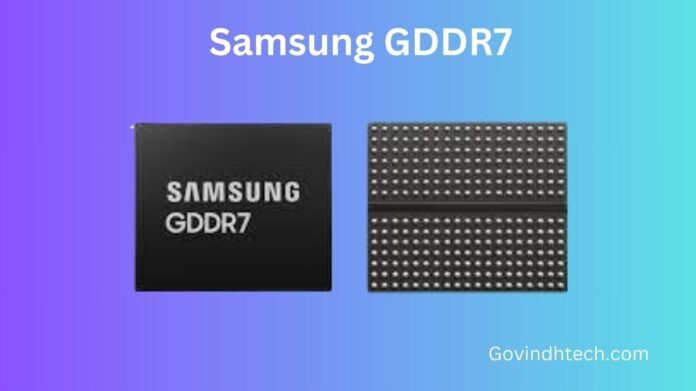GDDR7 Graphics Card
The first GDDR7 memory modules that will power the upcoming next-generation GPUs that will launch later this year have officially been listed by Samsung. Samsung Announces GDDR7 Memory Officially: Next-Gen GPUs Will Now Sample 28 Gbps and 32 Gbps DRAM
Samsung is among the three memory producers that will provide graphics suppliers like NVIDIA, AMD, and others with their next-generation GDDR7 memory solutions. The other two, Micron and SK Hynix, have also shown their current-generation devices and hinted at the potential of the new standard, which offers pin speeds of up to 40 Gbps and densities of up to 64 Gb.
GDDR7 Speed
Regarding Samsung, the corporation intends to adhere to a more rational 16 Gb density, permitting a 2 GB VRAM capacity per module. Thus, the capabilities will essentially remain unchanged from the graphics cards of the present generation. Every module will have a refresh rate of 16K/32ms and a 32-bit wide bus interface. The 266 FBGA package will include the GDDR7 memory modules, which are presently available in two speeds.
GDDR6 vs GDDR7
They have both the low-voltage optimized 28 Gbps die and the conventional 32 Gbps die. Very likely, only a few high-end models or their refreshes would have 32 Gbps pin speeds in the first version of GDDR7 GPUs, which would use the 28 Gbps dies. Both will be a significant upgrade over GDDR6, which has a maximum throughput of 24 Gbps and maximum throughput of just 22.5 Gbps on certain GPUs, such as the NVIDIA GeForce RTX 4080 SUPER. That is a speed gain of 42% for the 32 Gbps and 24.5% for the 28 Gbps.
Additionally, Samsung recently showcased its GDDR7 memory modules at GTC; as of right now, they are in the sample stage. Some of the setups you might anticipate with 28 Gbps and 32 Gbps modules are as follows:
GDDR7 Release Date
The first GDDR7 graphics cards will most likely be released later this year when the new memory’s manufacture picks up speed. The client graphics memory market as a whole will be starting again, and everyone is excited to see where it goes.
Excellent speed for more applications
Extending the reach of GDDR
GDDR7 is a significant advancement in computer graphics that may be used in graphics cards, gaming consoles, automobiles, HPC, and
It is the first DRAM to enable PAM3 signaling. Its 20% boost in power efficiency and 30% increase in speed make it the best option for a wide range of applications. Additionally, it delivers improved reliability with a 70% reduction in heat resistance because to newly developed packaging materials and an optimized circuit architecture.
With all these features GDDR7 is essential for AI
Greater speed, made possible by PAM3
The fastest performance currently offered by any standardized graphics memory device is provided by Samsung’s GDDR7. The first use of PAM3 signaling in the industry allows for this performance. With PAM3 transmitting 1.5 times more data in a single signal cycle than the traditional NRZ technique, GDDR7 outperforms its predecessor by 30%.
Optimized power use to guarantee economical operations
GDDR7 increases power efficiency by 20% by optimizing power. This kind of optimization results in a 50% reduction in standby power usage, which lowers total power consumption. Customers’ total cost of ownership (TCO) is lowered as a result of lower expenses resulting from less power use.
Ultimate stability
Gain from increased dependability. With the help of improved circuit architecture and innovative packaging materials, GDDR7 reduces heat resistance by 70%. This enables it to reduce overheating, which averts possible hardware problems, performance loss, and product deterioration.
FAQS
What is Samsung GDDR7?
The newest graphics memory technology produced by Samsung is called Samsung GDDR7. Its purpose is to provide significant improvements in performance over earlier generations, such GDDR6.
What are the benefits of Samsung GDDR7?
A few advantages of Samsung GDDR7 are as follows:
* Quicker rates: GDDR7 produces a bandwidth of 1.5 terabytes per second (TBps) with per-pin speeds of up to 37Gbps. Compared to GDDR6’s 1.1 TBps, this is a significant gain.
* Enhanced energy efficiency: GDDR7 uses 20% less energy than GDDR6 even with its faster speed.
* Improved thermal performance: To reduce heat resistance by 70%, Samsung used innovative circuit designs and packaging materials. By doing this, performance deterioration and overheating are less likely.
How fast is Samsung GDDR7?
Samsung GDDR7 has two important speed metrics to its name:
Per-pin speed: The data transmission rate for each individual memory chip pin is referred to here. Samsung offers 28 and 32 Gbps GDDR7.
Bandwidth: This represents the memory’s overall data transmission capability. The remarkable 1.5 terabytes per second (TBps) of bandwidth provided by GDDR7 is a major gain above the 1.1 TBps GDDR6 provided.
Pulse Amplitude Modulation (PAM3) signaling method is what gives GDDR7 its greater speed. PAM3 permits transfer of 50% more data in a single cycle as compared to the conventional Non-Return-to-Zero (NRZ) approach used in GDDR6. This corresponds to a 30% increase in performance over GDDR6.
Remember that GDDR7 is still at the research stage and that industry demand will probably determine when it becomes available for consumer goods like graphics cards.
Samsung GDDR7 Memory Specs
| Feature | Description |
|---|---|
| Technology | GDDR7 DRAM |
| Developer | Samsung Electronics |
| Status | In development |
| Performance | Up to 1.5 terabytes per second (TBps) bandwidth |
| Speed | Up to 37 Gbps per pin |
| Improvement over GDDR6 | 30% performance increase, 1.4x bandwidth |
| Signaling Method | Pulse-Amplitude Modulation (PAM3) |
| Thermal Resistance | 70% decrease compared to GDDR6 |
| Applications | Workstations, PCs, gaming consoles, AI, HPC, automotive |

